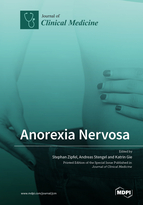Anorexia Nervosa
A special issue of Journal of Clinical Medicine (ISSN 2077-0383). This special issue belongs to the section "Clinical Neurology".
Deadline for manuscript submissions: closed (31 January 2019) | Viewed by 75308
Special Issue Editors
Interests: anorexia nervosa; eating behavior; obesity; psychooncology; psychotherapy
Special Issues, Collections and Topics in MDPI journals
Interests: anorexia nervosa; brain–gut axis; hunger and satiety; obesity; psychogastroenterology; psychoendocrinology
Interests: anorexia nervosa; binge eating disorder; body image; impulsivity; obesity; psychotherapy
Special Issues, Collections and Topics in MDPI journals
Special Issue Information
Dear Colleagues,
Anorexia nervosa (AN) is a severe eating disorder characterized by substantial underweight (Body Mass Index BMI ≤ 17.5 kg/m²). Further core symptoms of the disorder encompass an intensive fear of gaining weight and body image disturbances. AN is associated with considerable morbidity and mortality and often shows a long-standing course. Quality of life is poor and the burden placed on individuals, families, and society is high. Although in recent years progress has been made in the understanding of how this disorder is developed and maintained and how affected patients can be treated, many unmet challenges remain in the management of AN. The purpose of this Special Issue is to give an update on the evidence concerning a broad range of topics related to AN, encompassing findings on pathophysiology and pathopsychology of AN, complications as well as novel and innovative treatments of the disease and bring together world-renowned experts in the field.
Prof. Dr. Stephan Zipfel
Prof. Dr. Andreas Stengel
Prof. Dr. Katrin Giel
Guest Editors
Manuscript Submission Information
Manuscripts should be submitted online at www.mdpi.com by registering and logging in to this website. Once you are registered, click here to go to the submission form. Manuscripts can be submitted until the deadline. All submissions that pass pre-check are peer-reviewed. Accepted papers will be published continuously in the journal (as soon as accepted) and will be listed together on the special issue website. Research articles, review articles as well as short communications are invited. For planned papers, a title and short abstract (about 100 words) can be sent to the Editorial Office for announcement on this website.
Submitted manuscripts should not have been published previously, nor be under consideration for publication elsewhere (except conference proceedings papers). All manuscripts are thoroughly refereed through a single-blind peer-review process. A guide for authors and other relevant information for submission of manuscripts is available on the Instructions for Authors page. Journal of Clinical Medicine is an international peer-reviewed open access semimonthly journal published by MDPI.
Please visit the Instructions for Authors page before submitting a manuscript. The Article Processing Charge (APC) for publication in this open access journal is 2600 CHF (Swiss Francs). Submitted papers should be well formatted and use good English. Authors may use MDPI's English editing service prior to publication or during author revisions.
Keywords
- Anorexia nervosa
- Body image
- Body weight
- Eating disorders
- Emotion regulation
- Food
- Physical activity
- Psychotherapy
- Neurobiology
- Treatment
- Underweight








